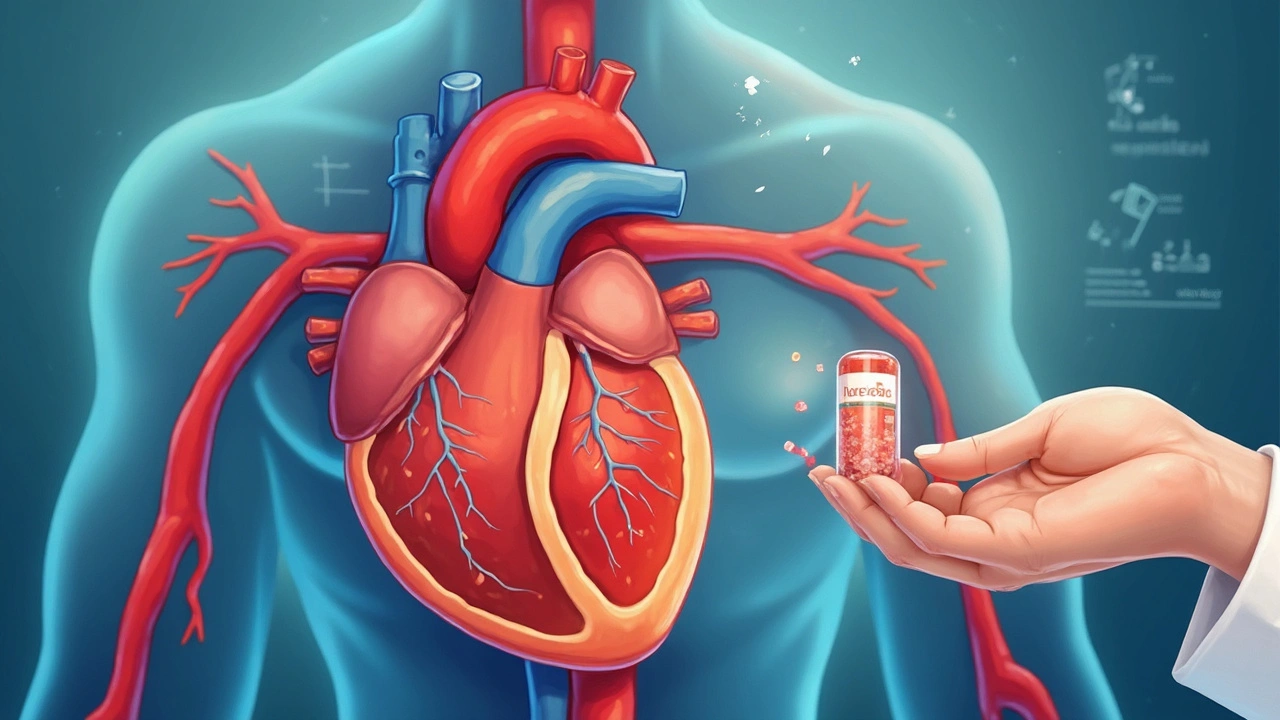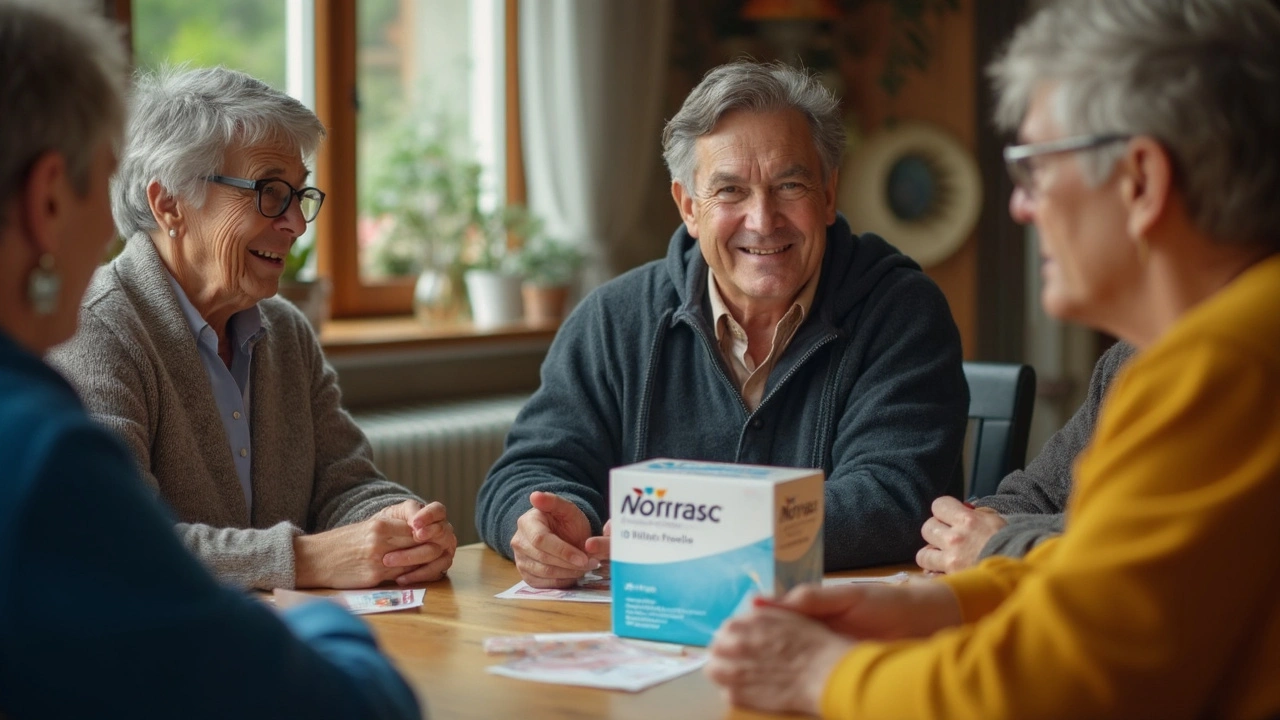
Picture this: High blood pressure, sometimes called the silent killer, creeps up on more people every year. It’s not always about the salty chips or stressful days—sometimes genetics just does us dirty. If you’ve ever sat in a doctor’s office in Sydney and been handed a script for Norvasc, you probably had a dozen questions swirling before you even handed it over to the chemist. Norvasc is everywhere. In 2024 alone, nearly 2 million scripts were filled for amlodipine in Australia. So what’s all the fuss? Why do doctors trust this pill, and how are folks actually feeling on it?
What is Norvasc and How Does it Work?
You might have heard Norvasc called by another name: amlodipine. That’s its generic title, but Norvasc has this almost household brand feel by now. It belongs to a family of medicines called calcium channel blockers. What does that mean in plain English? It relaxes and widens your blood vessels. When your arteries chill out a bit, blood flows more freely, and—voilà—your blood pressure drops. Not only does it help with high blood pressure (hypertension), but it’s also prescribed for angina, which is basically chest pain from not enough blood making it to your heart muscle.
Doctors like Norvasc because it works steadily. You don’t get those wild swings—one day super-low, the next back in the danger zone. Instead, it offers a sort of smooth, background control. Lots of people start on a low dose, usually 5 mg once daily, before deciding if they need to bump it up to 10 mg. One cool thing? You don’t have to stress too much about timing it with meals; take it with or without food.
Kids as young as six sometimes get Norvasc for blood pressure issues, which surprises a lot of parents. In adults, especially those over 60, it’s one of the preferred starting meds. Unlike some other options, Norvasc usually doesn’t aggravate conditions like asthma or diabetes, making it handy when you’ve got a few health quirks going on.
And it doesn't just help with numbers on a screen. Lowering your blood pressure can actually reduce your chances of having a stroke, heart attack, or even kidney problems down the line. The numbers say it all: according to a study from The Medical Journal of Australia, every 10 mm Hg drop in systolic blood pressure means a 25% lower risk of big bad heart events. That’s a pretty convincing reason to stick with the program.
Here’s a quick data snapshot about Norvasc and who’s using it in Australia these days:
| Year | Scripts Filled | Average Daily Dose (mg) | Most Common Age Group |
|---|---|---|---|
| 2022 | 1.7 million | 5 | 60-74 |
| 2023 | 1.9 million | 5 | 60-74 |
| 2024 | 2.1 million | 5 | 60-74 |
So, if Norvasc pops up on your script, you’re hanging out with a big crew using it every single day.
Common Side Effects: What to Expect (and When to Call the Doc)
If you’re like most people, you check the little leaflet you get with your box of pills, and it’s like reading a horror novel—long lists of side effects that make you question taking anything at all. Norvasc isn’t totally innocent, but for most people, side effects are pretty mild. The one you hear about the most? Swollen ankles or feet. That’s edema, and it’s super common, especially in the first few weeks. Why? As your blood vessels widen, a bit of fluid escapes into the tissues around your legs and feet.
Headaches might show up too, but they tend to fade fast. Some people complain about feeling flushed, kind of like they’re blushing for no reason. Fatigue isn’t as much of an issue as you’d expect. A handful of people notice dizziness, especially if they stand up suddenly. If you’re a gym-goer or always on the move, pay attention to how you’re feeling. A quick sit and a sip of water usually does the trick if you get lightheaded.
It’s rare, but some folks get heart palpitations—like your heart is flipping or skipping a beat. Some people experience mild chest pain. Now, that sounds scary, and you absolutely should see your doc if you notice these. Allergic reactions are possible too but extremely unusual. The main signs to look out for are rash, itching, severe dizziness, or trouble breathing. Don’t play the tough guy—ring up your GP or go to the emergency room if anything feels way off.
There’s a handy trick some Aussie GPs use for leg swelling: elevate your feet when watching TV or before bed. Compression socks aren’t just for grandmas anymore. If edema is bugging you, ask about these simple hacks before giving up on the medicine altogether.
Here’s an at-a-glance table showing the most common Norvasc side effects and how often they show up (based on real-life prescription data):
| Side Effect | How Common? |
|---|---|
| Swollen ankles/feet | 1 in 10 |
| Headache | 1 in 20 |
| Flushing | 1 in 20 |
| Dizziness | 1 in 30 |
| Irregular heartbeat | 1 in 100 |
| Allergic reaction | Less than 1 in 5,000 |
Always check in with your doctor if you’re worried. It’s better to ask and feel like a pest than ignore something that could become a big problem.

Smart Tips for Taking Norvasc (And Sticking With It)
We all know what it’s like to start a new medication with the best of intentions, only to forget about it a week later. Norvasc works best if you take it exactly as your doctor prescribes, so let’s break down how to make it fit into your real life.
- Pick a solid daily routine. Some people link it with brushing their teeth—tablet, toothbrush, job done.
- If you miss a dose, don’t double up. Just take it as soon as you remember, but skip it if it’s nearly time for the next one.
- Set reminders on your phone if you’re prone to forgetting. There are apps designed just to nag you about taking meds.
- Don’t play chemist—don’t adjust your dose or stop suddenly without your doctor’s advice. Blood pressure can spike if you quit cold turkey.
- Alcohol won’t directly mess with Norvasc, but it can mess with your blood pressure. Go easy, especially when you’re new to the medication.
- Salt matters. If you’re still salting everything, Norvasc may have to work harder than it should.
- Some juices—like grapefruit—can interfere with the enzyme pathways that process Norvasc, raising your risk of side effects. Skip the grapefruit juice.
- If travel is in the cards, make packing your Norvasc as automatic as grabbing your charger. Altitude, jet lag, weird eating schedules—they can all play with your blood pressure, so don’t leave your pills behind.
- Keep track of your own blood pressure at home. Home monitors aren’t expensive anymore, and they can be motivating. Seeing good numbers helps you stick with the plan.
Lots of Sydney doctors now encourage patients to join online support groups or download apps that track blood pressure. The more you’re in the loop about your own health, the more likely you’ll stay on track.
Norvasc and Everyday Life: What Changes Should You Expect?
So what’s day-to-day life actually like when you’re on Norvasc? For most, it becomes just another thing in the morning routine, not much different from making a cuppa. After a few days, you’ll probably notice, well, nothing much at all—and that’s a good thing. This medication doesn’t usually give you a hit of energy or a crash, it just does its sneaky work in the background.
A few weeks in, some notice their ankles or feet getting a bit puffy after standing all day, especially if Sydney summer is kicking in and you’re spending time outdoors. If this happens, elevating your feet and taking short walks actually helps. For some, starting Norvasc slows them down a tad, not with tiredness, but maybe they’re a little dizzy the first week or two when hopping out of bed. This usually passes once your body adjusts.
If you’re big on sports, running, or cycling, you shouldn’t have to slow down. Most Aussies on Norvasc keep up their regular exercise routines. If you notice your endurance is off or you feel more breathless than usual, have a word with your GP. It could just be your blood pressure settling, or it could mean the dose needs tweaking.
And let’s talk about driving. A common question is: can you still drive on Norvasc? For pretty much everyone, yes. But don’t get behind the wheel if you’re feeling dizzy or lightheaded until you know how the medication settles for you. Think of it as the same rule as when you try a new allergy tablet or cold pill.
Norvasc isn’t known for playing havoc with your sex life, which sets it apart from other blood pressure meds. Men sometimes worry about erectile dysfunction with heart drugs, but Norvasc doesn’t have a reputation for causing issues.
If you’re planning on getting pregnant or are breastfeeding, it’s time for a fresh chat with your doctor. The safety of Norvasc in pregnancy hasn’t been totally nailed down, so don’t just keep taking it without getting a review.

Combining Norvasc with Other Medications and Lifestyle Choices
By now, you’re probably seeing the pattern: Norvasc is built for convenience and long-term use, but it’s smart to know what can mess with it. The biggest mix-ups come when you add new meds—like antibiotics, antifungals, or medicines for heart rhythm. These can boost Norvasc’s levels in your system, meaning more side effects. So, whenever you’re given something new, mention your Norvasc.
Not all over-the-counter meds are friendly, either. Anti-inflammatories like ibuprofen can raise your blood pressure and undo some of the good Norvasc is doing. Always check with a pharmacist if you’re grabbing cold or pain medicine, especially if you’re taking several prescriptions.
Diet plays a role too. Most people focus on salt, but potassium is important as well. Some people on blood pressure meds end up with too much potassium (especially if they’re mixing with other meds), while others need to watch out for not enough. Stick with a sensible, balanced diet. There’s nothing wrong with the occasional Tim Tam, but don’t go wild.
Let’s not forget about smoking. Lighting up a cig can increase heart disease risk and blood pressure, making Norvasc work double time. If you’re thinking about quitting, even a small cut-back helps.
Regular check-ups are part of the package. Your doc will likely want to see you every 6 to 12 months to monitor how you’re going. Sometimes they’ll order blood tests for your liver, kidneys, and electrolytes—just to be sure you’re tolerating Norvasc without any silent side effects.
Finally, stress matters more than you think. Whether it’s work, finance, or just Sydney traffic, everyday stress can put your blood pressure in the red. Mindfulness, walking the Bondi to Coogee trail, or weekend footy with mates—it all helps. Keeping your mind chilled means Norvasc doesn’t have to work quite as hard.
7 Comments
Write a comment
More Articles

Shortage Predictions: Forecasting Future Drug Scarcity 2025-2030
Drug shortages are accelerating due to global supply chain fragility, climate disruptions, and geopolitical tensions. Learn how forecasting tools are evolving-and what you can do to protect your access to essential medicines.

Buy Cheap Generic Seroquel Online - Safe Guide 2025
Learn how to purchase cheap generic Seroquel safely online. Get price comparisons, buying steps, red‑flag warnings and tips for quality online pharmacies in 2025.

The connection between obesity and the need for penis surgery
As a blogger, I've discovered an interesting connection between obesity and the need for penis surgery. It turns out that excessive fat in the pubic area can lead to a buried or hidden penis, making it difficult for men to maintain proper hygiene and sexual function. This often requires surgical intervention to correct the issue. Furthermore, obesity contributes to other health issues like diabetes and heart disease, which can negatively impact sexual health. It's essential to maintain a healthy weight not only for overall well-being, but also for a fulfilling and healthy sex life.

Jonathan Debo
June 15, 2025 AT 05:55Let’s be clear: Norvasc is not a ‘miracle drug’-it’s a calcium channel blocker with a pharmacokinetic half-life of 35–50 hours, which explains its once-daily dosing regimen. The 5 mg to 10 mg titration is standard, but what’s rarely discussed is the CYP3A4 enzyme inhibition potential when combined with macrolide antibiotics or azole antifungals-this can elevate plasma concentrations by up to 40%, increasing edema risk. Furthermore, the claim that ‘it doesn’t aggravate asthma’ is misleading; while it’s safer than beta-blockers, it still carries a Class II warning for patients with severe peripheral edema or hepatic impairment. The data cited from the Medical Journal of Australia? Correlation isn’t causation-and the 25% risk reduction is relative, not absolute. Absolute risk reduction? Closer to 1.5% over ten years. Don’t let marketing masquerade as medicine.